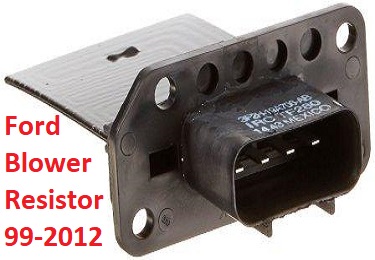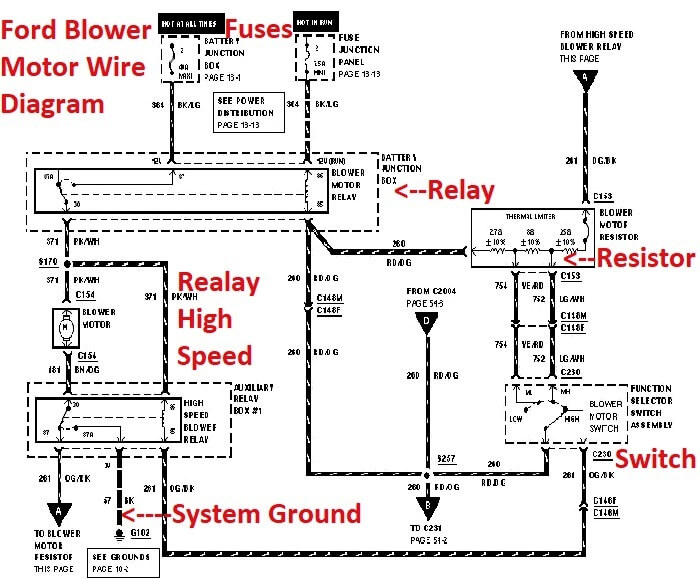Ford Blower Motor Resistor
Ford blower motor resistor problems remain the most common solution
to interior fan malfunctions on Ford cars and trucks.The blower motor wiring diagram is at the bottom of this page.
With that said, failed blower resistor assemblies don't solve all of the possible failures. This is why at the bottom of the article we include the Ford wire diagram.
The interior fan is powered through two separate fuses and a blower motor relay. They control the HVAC circuit with a switch.
On the automatic temperature control system they further complicate the system by using a module. Malfunction of these components can cause different symptoms and that's where we’ll start.
Quick Links: New Ford blower motor resistor kit with harness and connector.
For Ford cars and trucks without ATC (Automatic Temperature Control) systems diagnosis becomes simpler.
In addition, the replacement parts are also less expensive. Before we move on I want to make one more important point.
Whether you have a blower motor problem on a 2009 Ford escape, 2004 Ford F150 pickup truck or even an Expedition or Mercury mariner these blower motor control systems use the same parts.
In addition, the wiring diagrams and the circuit operation also remain very much alike. However, the Ford Fusion blower motor resistor is a completely different animal.
 Ford Blower Motor Resistor Part
Ford Blower Motor Resistor PartCard Type Blower Motor Resistor
The thin card type Ford blower motor resistor is the most common part used for the interior fan speed control.
It fits almost all of the truck and sport utility vehicles like the Ford Escape, Expedition, Explorer and Lincoln Navigator from 1999 through 2012.
When this resistor module fails drivers often complain about losing individual blower motor speeds.
Sometimes you will only have low and high speed settings. However, the most common complaint when this part fails is the blower only works on high.
If you look at the wiring diagram for the Ford F150 below, you'll see that the high speed setting bypasses the resistor assembly completely. If you're blower motor works on high and you have the card type Ford blower motor resistor, no further diagnosis is required.
With the low cost of the replacement part and the high failure rate, I'll just go ahead and replace it.
If you smell some electrical burning or melting odor, the four wire connector that plugs into the resistor module needs a thorough inspection.
Often the connector melts, and the heat can burn and distort the terminals. If you observe any damage or discoloration of the terminal, you should replace the connector. You can purchase these pigtail electrical connectors separately.
Ford Blower Motor Resistor Problems
 Ford Blower Resistor and Connector Kit
Ford Blower Resistor and Connector KitWhen you have blower motor speed control problems on a Ford with ATC the failure can still point to a failed resistor module. However, the part looks a lot different than the card type module discussed above.
It's important to verify the correct replacement part as variations exist throughout the different years and models. The Ford blower motor resistor deployed on the automatic temperature control systems is larger and has aluminum heat sinks incorporated into the design.
These cooling fins channel heat away from the internal electrical components. Since the resistor fits into the heater case they direct air created by the spinning fan, across the heat sink fins.
This is an efficient way of cooling down the entire module assembly. Unfortunately, failure of the component still remains possible despite the best efforts of cooling the parts down.
In fact, overheating of the resistor becomes more likely to damage the electrical connector that plugs into the assembly. For this reason they now sell replacement parts that include the replacement connector referred to as a pigtail.
As you can see from the image, they also include heat shrink connectors. They shrink to form a weather tight seal around the electrical wire repair. When you buy replacement blower motor resistor modules from the Ford dealer they are much more expensive and they sell the pigtail connectors separately.
Other Ford Blower Motor Problems
Before we get into other Ford blower motor speed control problems let's talk about what happens when the fan motor doesn't work at all. In many cases when this situation occurs, you have a blown fuse.
As you can see from the wiring diagram below, there are two fuses protecting the circuit. Both of these need to be intact for the blower motor to operate properly.
The question becomes, why did the fuse pop? It's possible for the electrical failure of the blower motor resistor to take out one or both of these fuses as it melts. In addition you could have a melted resistor connector.
If the blower motor doesn't work at all, it's also common to find a defective blower motor relay. Note that the interior fan circuit contains two relays in the same way that it contains two fuses. You can verify this in the Ford F150 blower motor diagram below.
If the blower motor doesn't work at all, you probably have a defective relay. However, if the only speed the fan is missing is the high setting than the likely cause of the problem becomes the high-speed relay.
With that said, remember it’s possible for the blower motor to fail itself. Although the motor is one of the most reliable components of the system it won’t last forever.
Now let’s cover the least likely cause of problems with the interior fan speed settings. Both the automatic temperature control and the standard air-conditioning systems use switches on the control panel.
Although switch failure remains uncommon compared to all the other possibilities, it still remains possible for the switch to fail.
 Ford Blower Motor Wire Diagram
Ford Blower Motor Wire DiagramAuthor bio : Mark is a retired ASE certified master technician, Chevrolet Professional Service Council member and the founder of FixMyOldRide.com. Watch the video on the about Mark the mechanic page to see his credentials, awards and certifications for yourself. Mark hand writes all of the articles on FixMyOldRide.com unless indicated otherwise.